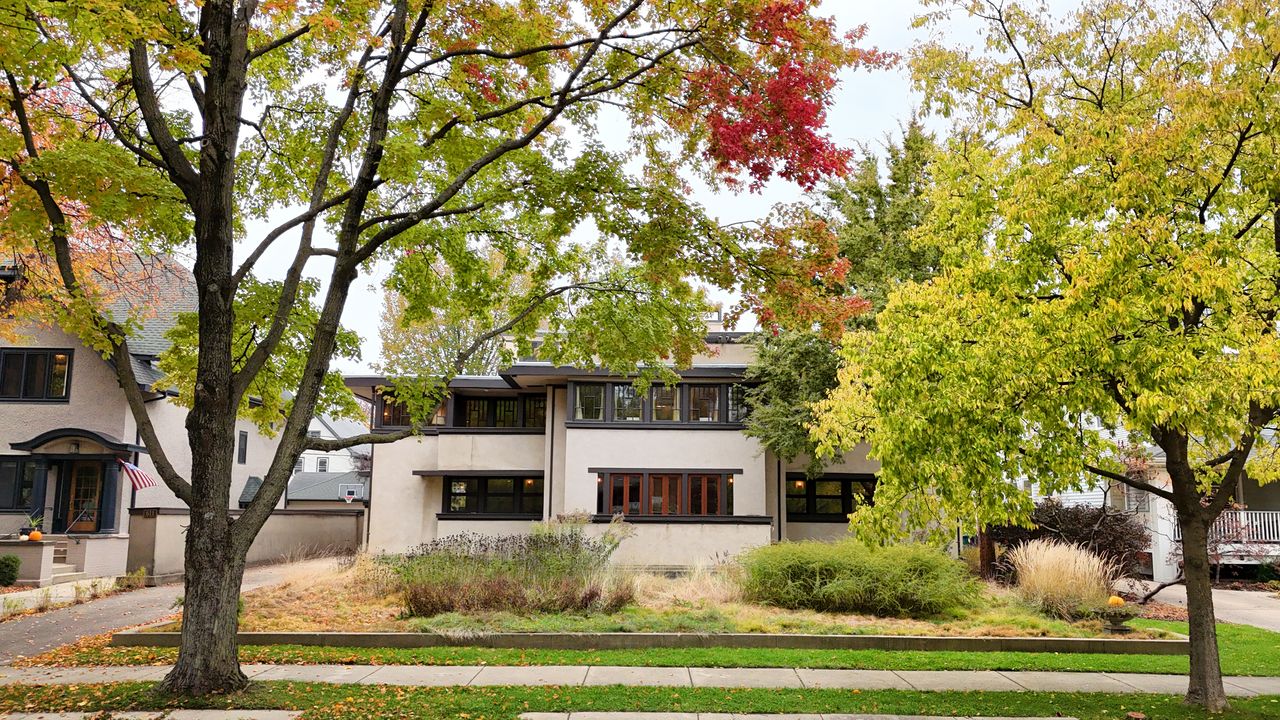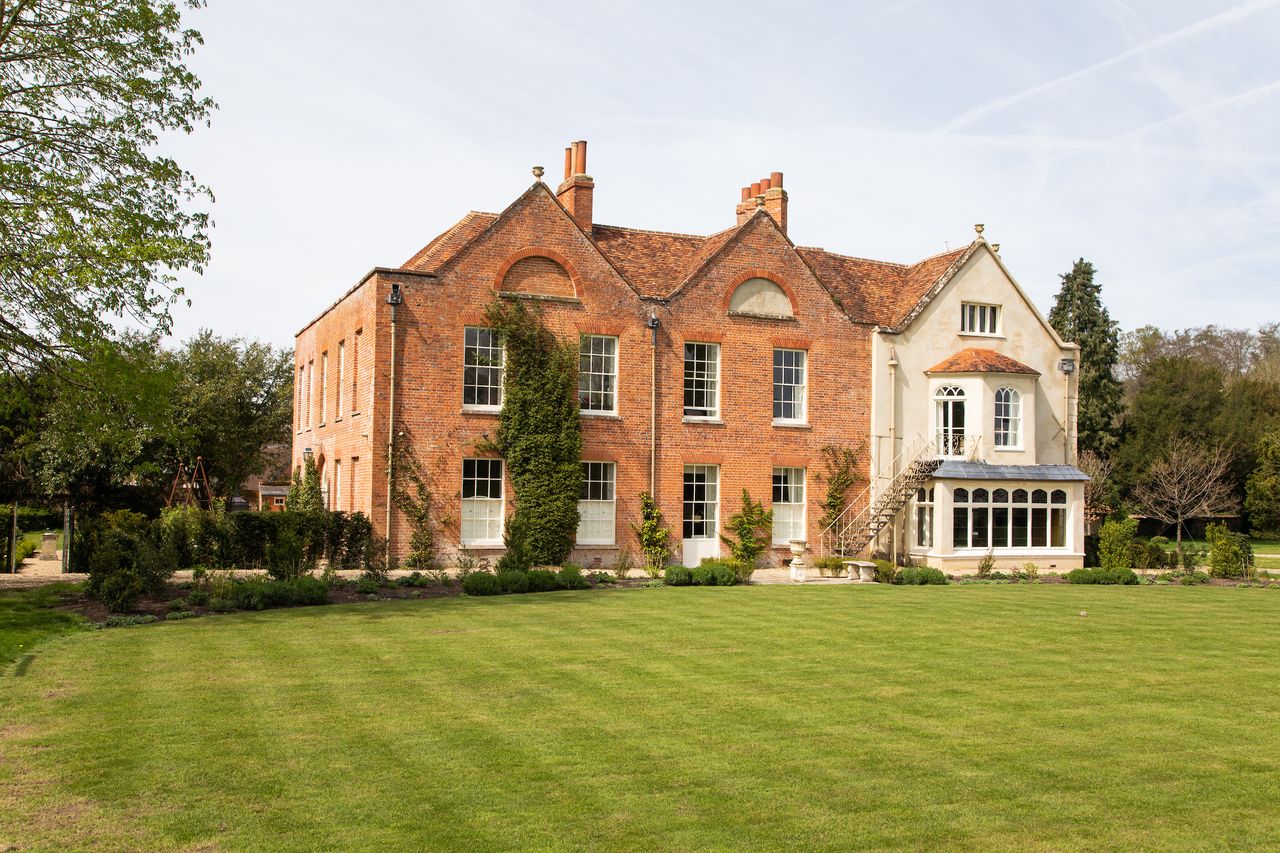Inside the $800,000 Experiment to Turn a Frank Lloyd Wright Into a Net-Zero Energy Home
A native New Yorker launched an ‘environmentally focused’ renovation to bring an architecturally significant Illinois home into the 21st century
“I was not planning to buy a Frank Lloyd Wright house,” says Samantha Lotti, who grew up in a Manhattan apartment, studied at the University of Chicago, and then spent five post-college years running her family’s farm in Tuscany. So in 2016, when she heard that the Oscar B. Balch House, one of more than two dozen Wright buildings in Oak Park, Ill., was for sale, she was only vaguely interested. But she did go look. And when she entered the main living space of the 1911 prairie-style house, which is named for its first owner, she says, “I fell in love.” Among the things that moved her were the size of the windows and the proportions of the rooms. The ceilings are low, “almost compressive,” she says, “which is intended to force you to engage with what’s outside the house. And, thanks to the windows, you feel like you’re outside when you’re inside.”
Within weeks, she was in contract to buy the house for $1,126,800, about 10% below asking, which, to a New Yorker, seemed like a bargain. The house had a lot going for it. It is part of a gracious neighbourhood of historic residences, including Wright’s own Home and Studio. And it was in excellent condition, thanks to its previous owner, Tim Pearson, an accountant and construction company executive, who between 1999 and 2016 restored much of the original building while adding a very large kitchen and great room to the back of it. That increased the house’s size to 4,400 square feet without altering its symmetrical front elevation. Though the house is closely watched by Wright enthusiasts, the only parts of it with legal protection are two spectacular Wright-designed glass light fixtures that Pearson deeded to the Frank Lloyd Wright Building Conservancy. Lotti, 39, jokes that she could gut the entire house as long as she didn’t touch the fixtures.
But she’s not about to gut anything. Every morning, Lotti says, “I wake up in a work of art.”
Though not a very energy-efficient work of art. Its 49 single-paned windows, many with bits of coloured glass in abstract patterns, provided little insulation. Nor was there much insulation in the walls and roof. During a “polar vortex” in 2019, Lotti, who practices Chinese medicine in Oak Park, ran the gas-fired boiler-and-radiator heating system at full blast, and still couldn’t get the indoor temperature above 55 degrees. Air conditioning the house in summer was equally difficult. “It was so expensive,” she says. “At night I’d turn it on only if it was 90-plus degrees.” Lotti was disturbed not just as a homeowner paying the utility bills, but also as an environmentalist. So she set out to make the Wright house green. She hoped it could even reach “net zero,” meaning it produced as much energy as it consumed. Like most users of the phrase net zero, she didn’t count, on the consumption side, the energy that went into building and renovating the house, known as embodied energy.
“It is extremely unusual to do a historic restoration that is so environmentally focused,” says Marsha Shyer, who chairs the homeowner committee of the Frank Lloyd Wright Building Conservancy. Owners of historic houses often simply live with inefficiency as the price of authenticity.
Getting to net-zero would mean tightening the building envelope to reduce the need for heating and air conditioning. She began with the roof, which not only leaked when it rained but was also far from airtight. Redoing it cost about $55,000, which, Lotti says, is more than she would have paid if she had hired an ordinary contractor. Instead, she chose one who specialises in historic preservation. “You always have to go up a level for Frank Lloyd Wright,” she says. That’s true even though the roof, which is flat, is visible only from above.
Next she had to insulate the space below the roof. That meant tearing out the original second-floor ceiling, which gave Lotti a chance to solve another problem: The flexible ductwork over the house’s bedrooms rattled when the air conditioning was on. Lotti decided to install new, rigid ductwork for both heating and cooling. Once the ductwork was in place, it was time to fill the remaining ceiling cavities with insulation. Until recently, blow-in insulation often contained HFCs (hydrofluorocarbons) that emitted greenhouse gases far more damaging to the environment than CO2. Instead, Lotti’s contractor used recently developed hydrofluoro olefin (HFO) spray foams, which are far less greenhouse gas-intensive.
Then it was time to restore the second floor ceilings, which had a sandy finish specified by Wright. To Lotti’s surprise, rebuilding the ceilings and giving them just the right texture cost about $50,000.
The other big contribution to making the house tighter was insulating its 49 single-pane windows. After speaking to contractors and preservationists about how to best achieve that, she decided to install interior storm windows. A carpenter spent months during the pandemic making pine-framed storm windows for a house where no two windows were precisely the same size (mostly due to settling). The storm windows are stunningly well-made; they are barely visible from inside or outside the house. Lotti spent $142,000 on those and other window and door restorations.
Then came the biggest job of all: replacing her gas-burning furnace and water heater with a geothermal system. That involved drilling six 450-foot holes in the front yard, running pipes into and out of the holes, then surrounding the pipes with charcoal, a good conductor of heat, bentonite, a kind of clay that expands as it dries, and sand. Water circulating through the pipes reaches a temperature of about 59 degrees. From there, just a bit of energy is needed to make it slightly hotter, for heating, or colder, for air conditioning. Digging the geothermal wells, running the pipes through them, and connecting those pipes to the forced-air system cost about $64,000, which was reduced by a 26% Illinois rebate. Lotti had to redo part of the basement floor ($29,000) to support the manifolds, which connect the geothermal wells to the house’s heating and cooling systems, as well as three big water-storage tanks, two bilge pumps, and other new equipment ($49,000). It cost $132,000 to add ductwork throughout the house—allowing for forced air heating and cooling. Electrical wiring for the system was another $26,000. Altogether, the heating and air conditioning improvements—from geothermal wells to ductwork—cost about $300,000.
Installing the geothermal system means Lotti no longer uses gas to heat the house, but it didn’t lower her electric bill. “It takes electricity to pump the water down 450 feet and back up 450 feet,” she says.
Lotti also took on several projects purely for aesthetic reasons, such as repainting the Greek key motif on the house’s exterior in its original grey colour. Another improvement was sybaritic: Lotti turned an enclosed porch on the back of the second floor into a sauna. Pearson had laid the groundwork for that and other nonessential projects.“ It’s because of him that I could do what I did,” Lotti says.
Before the renovation began, Lotti subjected the house to a blower door test, which measures the permeability of the building envelope. She performed another one almost three years later. The goal, she says, was to see if installing custom interior storm windows, insulating the second-floor ceilings and replacing the roof made the house tighter. It did, but not enough. “We failed,” says Lotti, “but we came much closer to passing than before.” The house still leaked like a sieve, mostly through the exterior walls. But the cost of insulating those walls, she says, was “prohibitive.” As a result, she says, “The house may never be net zero.”
Installing rooftop solar panels would have helped the house meet that goal. But she couldn’t have installed the solar panels while the roof and the ceiling (including the new ductwork) were being repaired. Once the ductwork was in place it made sense to complete the geothermal system. Then, when it was finally time to install the solar panels, workers had been in and out of the house nearly every day for three years. Lotti decided she needed a break.
She still hopes to install the solar panels, which, she believes, will cost about $27,000 before tax rebates. She expects utility bill savings would defray that cost over a period of years.
Altogether, Lotti spent about $800,000 on the house, a figure that includes engineering and site management fees and the cost of replacing a sewer line that broke when the geothermal wells were being dug.
So what had she accomplished? She had made the house all electric, with the exceptions of her two wood-burning fireplaces. An all-electric house has the potential to operate with almost no carbon emissions. It just takes a clean source of electricity, like the solar panels she hopes to install on the roof. Lotti also gained a lot of experience, which Shyer, herself the owner of a Frank Lloyd Wright house, has chronicled on the website of the Frank Lloyd Wright Building Conservancy, savewright.org. Says Shyer, “Samantha is using her house as a model for environmentally conscious historic preservation. It has certainly caught the attention of the Frank Lloyd Wright homeowner community.”
Lotti herself has chronicled her efforts in a series of highly informative Instagram posts. Looking back on the three years she dedicated to upgrading the house, she says, “We discovered what was possible, which is that the house could become significantly more energy efficient.” She adds, “Just like in medicine, we experiment. We come up with an idea that we think is going to be a solution, and then we discover that it isn’t. Humanity is all about trial and error. You don’t know unless you try.”
 Copyright 2020, Dow Jones & Company, Inc. All Rights Reserved Worldwide. LEARN MORE
Copyright 2020, Dow Jones & Company, Inc. All Rights Reserved Worldwide. LEARN MORE
This stylish family home combines a classic palette and finishes with a flexible floorplan
Just 55 minutes from Sydney, make this your creative getaway located in the majestic Hawkesbury region.
Ahead of the Games, a breakdown of the city’s most desirable places to live
PARIS —Paris has long been a byword for luxurious living. The traditional components of the upscale home, from parquet floors to elaborate moldings, have their origins here. Yet settling down in just the right address in this low-rise, high-density city may be the greatest luxury of all.
Tradition reigns supreme in Paris real estate, where certain conditions seem set in stone—the western half of the city, on either side of the Seine, has long been more expensive than the east. But in the fashion world’s capital, parts of the housing market are also subject to shifting fads. In the trendy, hilly northeast, a roving cool factor can send prices in this year’s hip neighborhood rising, while last year’s might seem like a sudden bargain.
This week, with the opening of the Olympic Games and the eyes of the world turned toward Paris, The Wall Street Journal looks at the most expensive and desirable areas in the City of Light.
The Most Expensive Arrondissement: the 6th
Known for historic architecture, elegant apartment houses and bohemian street cred, the 6th Arrondissement is Paris’s answer to Manhattan’s West Village. Like its New York counterpart, the 6th’s starving-artist days are long behind it. But the charm that first wooed notable residents like Gertrude Stein and Jean-Paul Sartre is still largely intact, attracting high-minded tourists and deep-pocketed homeowners who can afford its once-edgy, now serene atmosphere.
Le Breton George V Notaires, a Paris notary with an international clientele, says the 6th consistently holds the title of most expensive arrondissement among Paris’s 20 administrative districts, and 2023 was no exception. Last year, average home prices reached $1,428 a square foot—almost 30% higher than the Paris average of $1,100 a square foot.
According to Meilleurs Agents, the Paris real estate appraisal company, the 6th is also home to three of the city’s five most expensive streets. Rue de Furstemberg, a secluded loop between Boulevard Saint-Germain and the Seine, comes in on top, with average prices of $2,454 a square foot as of March 2024.
For more than two decades, Kyle Branum, a 51-year-old attorney, and Kimberly Branum, a 60-year-old retired CEO, have been regular visitors to Paris, opting for apartment rentals and ultimately an ownership interest in an apartment in the city’s 7th Arrondissement, a sedate Left Bank district known for its discreet atmosphere and plutocratic residents.
“The 7th was the only place we stayed,” says Kimberly, “but we spent most of our time in the 6th.”
In 2022, inspired by the strength of the dollar, the Branums decided to fulfil a longstanding dream of buying in Paris. Working with Paris Property Group, they opted for a 1,465-square-foot, three-bedroom in a building dating to the 17th century on a side street in the 6th Arrondissement. They paid $2.7 million for the unit and then spent just over $1 million on the renovation, working with Franco-American visual artist Monte Laster, who also does interiors.
The couple, who live in Santa Barbara, Calif., plan to spend about three months a year in Paris, hosting children and grandchildren, and cooking after forays to local food markets. Their new kitchen, which includes a French stove from luxury appliance brand Lacanche, is Kimberly’s favourite room, she says.
Another American, investor Ashley Maddox, 49, is also considering relocating.
In 2012, the longtime Paris resident bought a dingy, overstuffed 1,765-square-foot apartment in the 6th and started from scratch. She paid $2.5 million and undertook a gut renovation and building improvements for about $800,000. A centrepiece of the home now is the one-time salon, which was turned into an open-plan kitchen and dining area where Maddox and her three children tend to hang out, American-style. Just outside her door are some of the city’s best-known bakeries and cheesemongers, and she is a short walk from the Jardin du Luxembourg, the Left Bank’s premier green space.
“A lot of the majesty of the city is accessible from here,” she says. “It’s so central, it’s bananas.” Now that two of her children are going away to school, she has listed the four-bedroom apartment with Varenne for $5 million.
The Most Expensive Neighbourhoods: Notre-Dame and Invalides
Garrow Kedigian is moving up in the world of Parisian real estate by heading south of the Seine.
During the pandemic, the Canada-born, New York-based interior designer reassessed his life, he says, and decided “I’m not going to wait any longer to have a pied-à-terre in Paris.”
He originally selected a 1,130-square-foot one-bedroom in the trendy 9th Arrondissement, an up-and-coming Right Bank district just below Montmartre. But he soon realised it was too small for his extended stays, not to mention hosting guests from out of town.
After paying about $1.6 million in 2022 and then investing about $55,000 in new decor, he put the unit up for sale in early 2024 and went house-shopping a second time. He ended up in the Invalides quarter of the 7th Arrondissement in the shadow of one Paris’s signature monuments, the golden-domed Hôtel des Invalides, which dates to the 17th century and is fronted by a grand esplanade.
His new neighbourhood vies for Paris’s most expensive with the Notre-Dame quarter in the 4th Arrondissement, centred on a few islands in the Seine behind its namesake cathedral. According to Le Breton, home prices in the Notre-Dame neighbourhood were $1,818 a square foot in 2023, followed by $1,568 a square foot in Invalides.
After breaking even on his Right Bank one-bedroom, Kedigian paid $2.4 million for his new 1,450-square-foot two-bedroom in a late 19th-century building. It has southern exposures, rounded living-room windows and “gorgeous floors,” he says. Kedigian, who bought the new flat through Junot Fine Properties/Knight Frank, plans to spend up to $435,000 on a renovation that will involve restoring the original 12-foot ceiling height in many of the rooms, as well as rescuing the ceilings’ elaborate stucco detailing. He expects to finish in 2025.
Over in the Notre-Dame neighbourhood, Belles demeures de France/Christie’s recently sold a 2,370-square-foot, four-bedroom home for close to the asking price of about $8.6 million, or about $3,630 a square foot. Listing agent Marie-Hélène Lundgreen says this places the unit near the very top of Paris luxury real estate, where prime homes typically sell between $2,530 and $4,040 a square foot.
The Most Expensive Suburb: Neuilly-sur-Seine
The Boulevard Périphérique, the 22-mile ring road that surrounds Paris and its 20 arrondissements, was once a line in the sand for Parisians, who regarded the French capital’s numerous suburbs as something to drive through on their way to and from vacation. The past few decades have seen waves of gentrification beyond the city’s borders, upgrading humble or industrial districts to the north and east into prime residential areas. And it has turned Neuilly-sur-Seine, just northwest of the city, into a luxury compound of first resort.
In 2023, Neuilly’s average home price of $1,092 a square foot made the leafy, stately community Paris’s most expensive suburb.
Longtime residents, Alain and Michèle Bigio, decided this year is the right time to list their 7,730-square-foot, four-bedroom townhouse on a gated Neuilly street.
The couple, now in their mid 70s, completed the home in 1990, two years after they purchased a small parcel of garden from the owners next door for an undisclosed amount. Having relocated from a white-marble château outside Paris, the couple echoed their previous home by using white- and cream-coloured stone in the new four-story build. The Bigios, who will relocate just back over the border in the 16th Arrondissement, have listed the property with Emile Garcin Propriétés for $14.7 million.
The couple raised two adult children here and undertook upgrades in their empty-nester years—most recently, an indoor pool in the basement and a new elevator.
The cool, pale interiors give way to dark and sardonic images in the former staff’s quarters in the basement where Alain works on his hobby—surreal and satirical paintings, whose risqué content means that his wife prefers they stay downstairs. “I’m not a painter,” he says. “But I paint.”
The Trendiest Arrondissement: the 9th
French interior designer Julie Hamon is theatre royalty. Her grandfather was playwright Jean Anouilh, a giant of 20th-century French literature, and her sister is actress Gwendoline Hamon. The 52-year-old, who divides her time between Paris and the U.K., still remembers when the city’s 9th Arrondissement, where she and her husband bought their 1,885-square-foot duplex in 2017, was a place to have fun rather than put down roots. Now, the 9th is the place to do both.
The 9th, a largely 19th-century district, is Paris at its most urban. But what it lacks in parks and other green spaces, it makes up with nightlife and a bustling street life. Among Paris’s gentrifying districts, which have been transformed since 2000 from near-slums to the brink of luxury, the 9th has emerged as the clear winner. According to Le Breton, average 2023 home prices here were $1,062 a square foot, while its nearest competitors for the cool crown, the 10th and the 11th, have yet to break $1,011 a square foot.
A co-principal in the Bobo Design Studio, Hamon—whose gut renovation includes a dramatic skylight, a home cinema and air conditioning—still seems surprised at how far her arrondissement has come. “The 9th used to be well known for all the theatres, nightclubs and strip clubs,” she says. “But it was never a place where you wanted to live—now it’s the place to be.”
With their youngest child about to go to college, she and her husband, 52-year-old entrepreneur Guillaume Clignet, decided to list their Paris home for $3.45 million and live in London full-time. Propriétés Parisiennes/Sotheby’s is handling the listing, which has just gone into contract after about six months on the market.
The 9th’s music venues were a draw for 44-year-old American musician and piano dealer, Ronen Segev, who divides his time between Miami and a 1,725-square-foot, two-bedroom in the lower reaches of the arrondissement. Aided by Paris Property Group, Segev purchased the apartment at auction during the pandemic, sight unseen, for $1.69 million. He spent $270,000 on a renovation, knocking down a wall to make a larger salon suitable for home concerts.
During the Olympics, Segev is renting out the space for about $22,850 a week to attendees of the Games. Otherwise, he prefers longer-term sublets to visiting musicians for $32,700 a month.
Most Exclusive Address: Avenue Junot
Hidden in the hilly expanses of the 18th Arrondissement lies a legendary street that, for those in the know, is the city’s most exclusive address. Avenue Junot, a bucolic tree-lined lane, is a fairy-tale version of the city, separate from the gritty bustle that surrounds it.
Homes here rarely come up for sale, and, when they do, they tend to be off-market, or sold before they can be listed. Martine Kuperfis—whose Paris-based Junot Group real-estate company is named for the street—says the most expensive units here are penthouses with views over the whole of the city.
In 2021, her agency sold a 3,230-square-foot triplex apartment, with a 1,400-square-foot terrace, for $8.5 million. At about $2,630 a square foot, that is three times the current average price in the whole of the 18th.
Among its current Junot listings is a 1930s 1,220-square-foot townhouse on the avenue’s cobblestone extension, with an asking price of $2.8 million.
This stylish family home combines a classic palette and finishes with a flexible floorplan
Just 55 minutes from Sydney, make this your creative getaway located in the majestic Hawkesbury region.






















